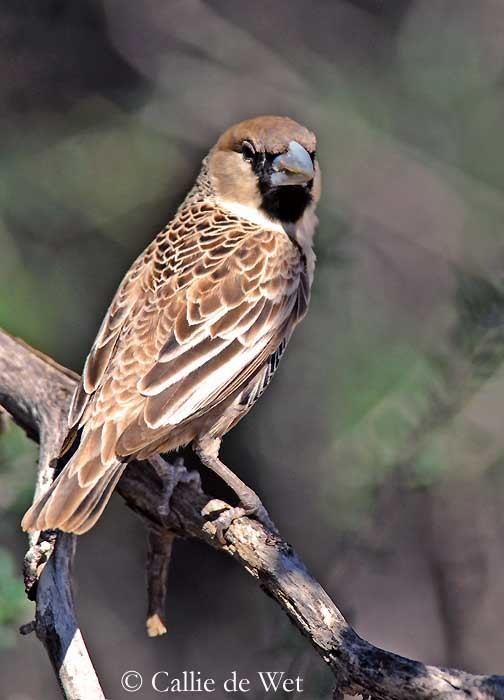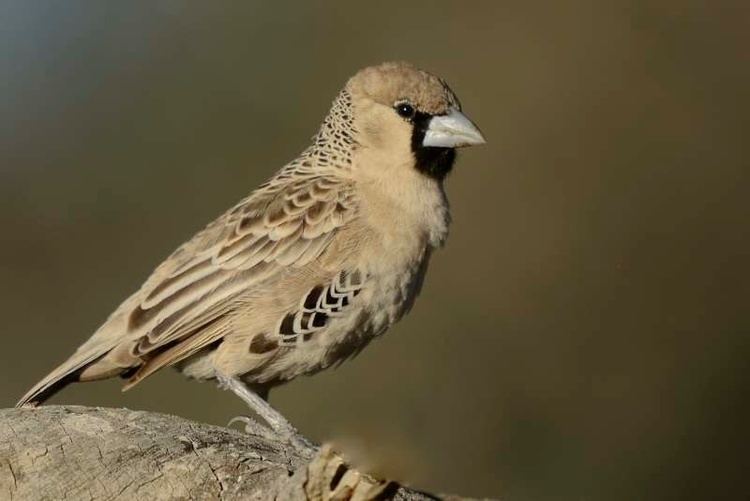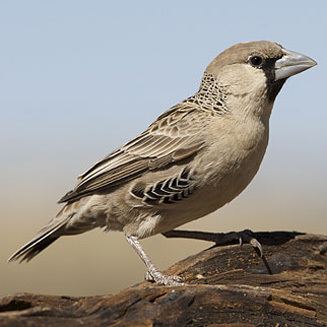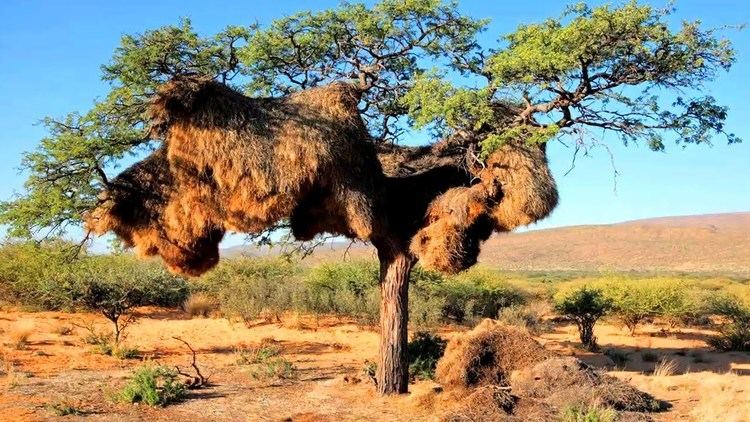Order Passeriformes Scientific name Philetairus socius Rank Species | Phylum Chordata Family Passeridae Higher classification Philetairus | |
 | ||
Genus PhiletairusA. Smith, 1837 Similar Bird, Weavers, Southern masked weaver, Baya weaver, Ploceus | ||
Sociable weavers
The sociable weaver (Philetairus socius), also commonly known as the common social weaver, common social-weaver, and social weaver, is a species of bird in the Passeridae family endemic to Southern Africa. It is monotypic within the genus Philetairus. It is found in South Africa, Namibia, and Botswana. but their range is centered within the Northern Cape Province of South Africa . They build large compound community nests, a rarity among birds. These nests are perhaps the most spectacular structure built by any bird.
Contents
- Sociable weavers
- Sociable weaver bird
- Taxonomy and systematics
- Description and identification
- Distribution and habitat
- Breeding
- Nesting
- Food and feeding
- Survival
- References

Sociable weaver bird
Taxonomy and systematics

The sociable weaver was first described by ornithologist John Latham in 1790. Four sub-species have been recognised. P. s. eremnus occurs around Orange River valley, while the nominate P. s. socius around Northern Cape Province and Namibia. Both the others, P. s. xericus and P. s. geminus occur in Namibia, the latter found in Etosha National Park and Owambo. This is the only living species in the genus Philetairus.
Description and identification

Measuring around 14 cm (5.5 in) in length, the sociable weaver has a black chin, black barred flanks and a scalloped back. They weigh 26–32 g (0.92–1.13 oz), and sexes are indistinguishable.
Distribution and habitat

The species ranges across northwestern South Africa, southwest Botswana and extending northwards across Namibia. It is strongly associated with the arid savannahs characteristic of the southern Kalahari region. The presence of stiff grasses such as Aristida ciliata and Stipagrostis, an important nesting material is an important determinant of its distribution. The taller grasses and the fire-prone nature of the Northern and Central Kalahari regions may be a factor for the absence of the bird in those regions. The area is semi-arid with low and unpredictable rainfall occurring mostly in the summer. The population has not been quantified but the birds are described as "common to abundant".
Breeding

In the southern range of the weaver's habitat, breeding may occur any time of the year and is closely linked to rainfall. In the northern range, discrete breeding season between December to August has been noted. They may skip breeding during years when there is low rainfall and a substantial number (sometimes over half) of birds in the colony may never breed in a given season. Under typical conditions, weavers raise up to four broods per breeding cycle. Sociable weavers are known to assist in the care of younger siblings and unrelated hatchlings and nearly all pairs are assisted by helpers. A mating pair has been recorded as producing nine broods in a single season in response to repeated predation of its young. Unlike northern temperate passerine birds which commence breeding within the first year of life, sociable weavers exhibit delayed onset of breeding, sometimes up to two years of age.
Nesting

Sociable weavers construct permanent nests on trees and other tall objects. These nests are the largest built by any bird, and are large enough to house over a hundred pairs of birds, containing several generations at a time. The nests are highly structured and provide birds with a more advantageous temperature relative to the outside. The central chambers retain heat and are used for nighttime roosting. The outer rooms are used for daytime shade and maintain temperatures of 7-8 degrees Celsius inside while outside temperatures may range from 16-33 degrees Celsius. Sociable weaver nests are used commensally by several other bird species, most commonly the pygmy falcon. Whereas this falcon is mostly believed to be an indifferent in most places, instances of predation of sociable weaver nestlings and animosity with the weavers has been reported from some sites in Kimberley. Red-headed finches and rosy-faced lovebird use the nests for breeding while other bird species such as acacia pied barbet, familiar chat and ashy tit may use it for roosting. Larger birds like owls and vultures use the nest as a platform to build their nests.

The nests consist of separate chambers, each of which is occupied by a pair (sometimes with offspring) roost and breed. Nests are built around large and sturdy structures like acacia trees or sometimes even telephone poles. The trees generally used for nest-building are Acacia erioloba, Boscia albitrunca and Aloe dichotoma. The birds at Etosha National Park also use Colophospermum mopane trees for nesting. Large nesting colonies can be active across many generations, sometimes over a hundred years. The nest appears like a large haystack in the tree. If seen from below, entrances into the chambers may be seen, giving a honey-comb appearance. The entrances may be about 3 in (76 mm) wide and can be up to 10 in (250 mm) long. Sharp sticks may be placed to deter predators from entering. Snakes, especially Cape cobras and boomslangs are the most common nest predators, often consuming all the eggs in all the chambers of a large nest. Nest predation is often as high - in one study 70% of the clutches laid were depredated.
Nests built in electricity poles sometimes cause short circuits in the rainy season and can catch fire in the dry season.
There is evidence that cooperation in nest-building is driven by kin selection.
Food and feeding
The sociable weaver is insectivorous with insects comprising 80% of their diet. As an adaptation to living in the dry Kalahari Desert, where standing water is scarce, the sociable weaver obtains all of its water from a diet of insects. They also feed on seed and other plant products. Foraging is predominantly on the ground, but also on bark and leaves of trees.
Survival
Populations of this bird has increased in this century, perhaps due to increased availability of nesting structures such as electricity pylons and other man-made structures. Most of its present distribution is unlikely to see any major man-made alteration and its future in these areas is secure. However, a gap in its distribution in the Northern Cape Province, north of the ghaap plateau is probably due to habitat alteration by clearance of Acacia. In other areas, encroachment due to overgrazing may also cause local extinction.
